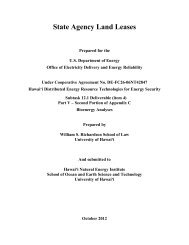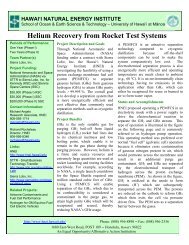Oahu Wind Integration Study - Hawaii Natural Energy Institute ...
Oahu Wind Integration Study - Hawaii Natural Energy Institute ...
Oahu Wind Integration Study - Hawaii Natural Energy Institute ...
Create successful ePaper yourself
Turn your PDF publications into a flip-book with our unique Google optimized e-Paper software.
1.1. Background<br />
<strong>Hawaii</strong>an Electric Company (HECO) is an investor owned utility serving the energy needs for<br />
the island of <strong>Oahu</strong> with approximately 295,000 customers. Annual energy production is<br />
approximately 8000 GWh and system load typically ranges from a peak of 1200 MW to a<br />
minimum of 600 MW. The total generating capacity of the system is 1756 MW comprised of<br />
HECO owned generating units and independent power producers (IPPs), primarily fossil-fueled<br />
units.<br />
<strong>Hawaii</strong>an Electric operates three power plants on the island of <strong>Oahu</strong> with a total of 17 generating<br />
units. These include (8) baseload steam units, (6) cycling steam units, and (3) three peaking<br />
combustion turbine (CTs) units. The steam units burn low sulfur fuel oil (LSFO); two CTs burn<br />
diesel fuel and one CT burns biofuel. The IPPs provide baseload energy, which includes: 1) a 46<br />
MW city-owned waste-to-energy unit (HPower), 2) a 180 MW coal-fired unit (AES), and 3) a<br />
208 MW LSFO-fired combined cycle unit (Kalaeloa). The baseload units operate continuously<br />
throughout the year except during maintenance outages. HECO-owned cycling units are<br />
committed daily to meet system demand and typically shut down following the evening peak.<br />
Peaking units are committed as required to meet system demand during system peaks and<br />
contingencies.<br />
Starting in January 2009, the <strong>Hawaii</strong> <strong>Natural</strong> <strong>Energy</strong> <strong>Institute</strong>, the <strong>Hawaii</strong>an Electric Company,<br />
and the General Electric Company jointly developed and validated detailed, state-of-the-art<br />
power systems models of the <strong>Oahu</strong> electrical system to study the impacts of integrating the “Big<br />
<strong>Wind</strong>” projects. Different models were developed to analyze various time scales of system<br />
operation ranging from seconds, to hours, to weeks, over an entire year of operation. These<br />
models were used to assess specific high wind power scenarios, identify the potential challenges<br />
of integrating large amounts of wind power, and assess potential solutions to these challenges.<br />
The Department of <strong>Energy</strong> (DOE), the <strong>Hawaii</strong> <strong>Natural</strong> <strong>Energy</strong> <strong>Institute</strong> (HNEI), and the<br />
<strong>Hawaii</strong>an Electric Company (HECO) provided funding for the <strong>Oahu</strong> <strong>Wind</strong> <strong>Integration</strong> <strong>Study</strong>. In<br />
addition to GE, HNEI and HECO, the project team included AWS Truepower, who provided<br />
wind power and wind forecast data, and the National Renewable <strong>Energy</strong> Laboratory, who<br />
provided wind and solar power data and validation of these data. The National Renewable<br />
<strong>Energy</strong> Laboratory also sponsored a Technical Review Committee (TRC), which was assembled<br />
five times during the project. The TRC consisted of technical experts from both industry and<br />
academia that brought experience from similar projects from around the world. The TRC<br />
provided oversight, guidance, and assessment of the work performed in this study.<br />
Simulations of the <strong>Oahu</strong> system were performed for the year 2014. Inputs such as system load,<br />
unit heat rates, fuel prices, planned unit maintenance, forced outage rates, etc. were based on<br />
forecasts provided by HECO. The wind plants located on Molokai and Lanai were electrically<br />
connected to <strong>Oahu</strong> via a High Voltage Direct Current (HVDC) cable system (see Figure 1-1).<br />
These wind plants were not connected to the local island loads. New, on-island resources were<br />
also modeled including 100 MW of wind power and 100 MW of combined centralized and<br />
distributed solar photovoltaic (PV) power.<br />
4




